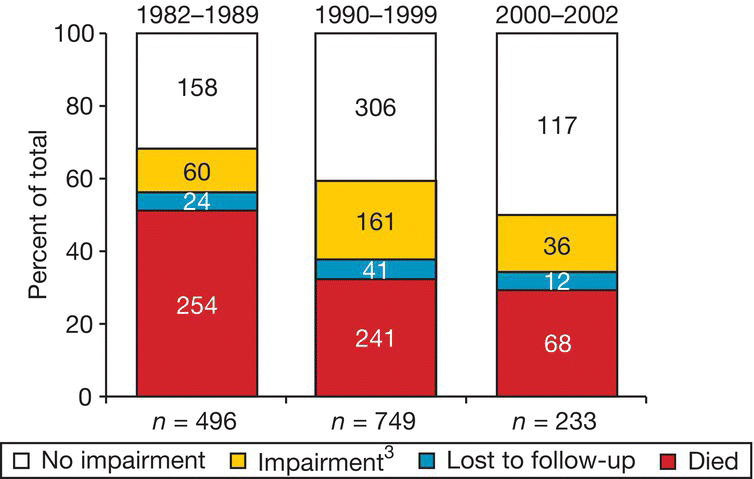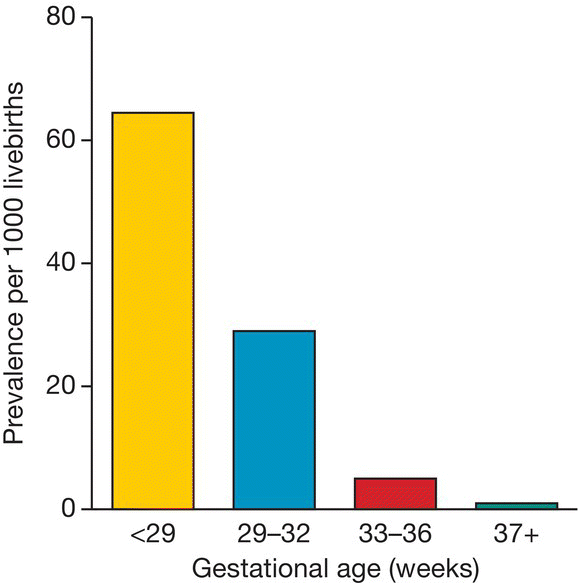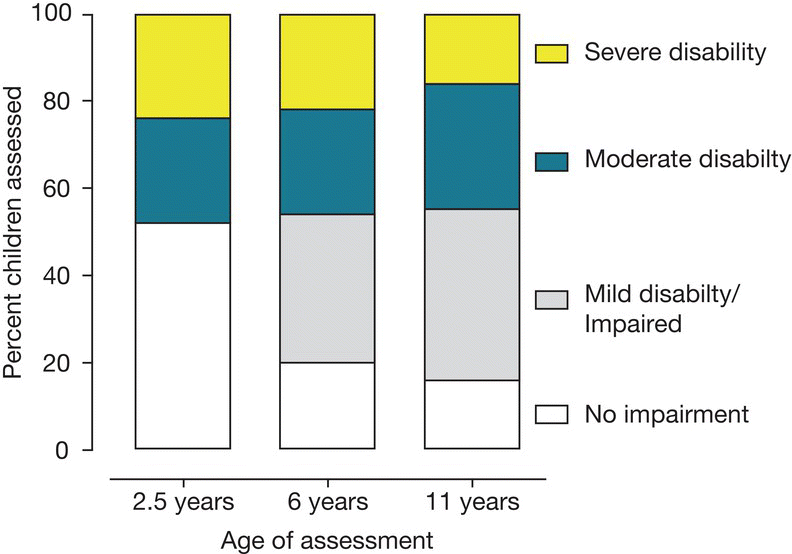38
Outcome of preterm infants
Survival in high-income countries of extremely preterm (<28 weeks) infants has increased dramatically, and many babies of 23–24 weeks of gestation now survive (Figs. 27.6 and 27.7). However, this increased survival has been achieved at the expense of high rates of neurodisability, although recent outcome data suggest that the neurodisability rates in early life are falling (Fig. 38.1).

Fig. 38.1 Neurodevelopmental outcome for babies of <1000 g birthweight over 20 years in a tertiary perinatal center. The proportion with impairment has decreased.
(Source: Wilson-Costello D. et al. Pediatrics 2007; 119: 37–45.)
The development of VLBW infants is monitored in a neonatal follow-up program (see Chapter 72) or in the community. Data from these programs can then be compared with other programs, but such comparisons may be misleading if based on an individual unit as the sample size will be small, with wide variations from year to year, and there may be differences in the demography of the mothers and referral patterns.
The most meaningful outcome data are regional or national, provided that the data collection is standardized and complete. A follow-up rate greater than 90% is desirable for all cohorts but difficult to achieve.
Growth
At discharge from hospital, over 90% of VLBW infants are below the 10th centile for weight, length and head circumference. Many show catch-up growth in the first 2–3 years, first of head circumference, then weight and then length. Growth is better if the infant is in good health. Catch-up growth may occur across childhood and adolescence, but may be less in infants with intrauterine growth restriction.
Medical complications
These include:
- bronchopulmonary dysplasia (BPD) – may require additional oxygen therapy for many months
- pneumonia/wheezing/asthma – more common with BPD
- bronchiolitis from RSV (respiratory syncytial virus) infection (hospitalization reduced by giving RSV monoclonal antibody, palivizumab)
- gastroesophageal reflux – especially with BPD
- complex nutritional and gastrointestinal disorders – following necrotizing enterocolitis or gastrointestinal surgery
- inguinal hernias – require surgical repair.
Rehospitalization rate is increased, mainly for respiratory disorders and surgical repair of inguinal hernias.
Disability and impairment
Neurodisability at 18 months to 2 years is usually classified (Table 38.1) as:
- severe – unable to walk, very low IQ, blind or profoundly deaf
- moderate – walk with support, IQ 55–70, hear with aids
- mild – less severe impairments, IQ 70–85.
Many studies combine the severe and moderate categories.
Table 38.1 Definitions of disability for use at 18–24 months of corrected age in follow-up of very preterm infants.
(Source: Classification of Health Status at 2 Years as a Perinatal Outcome. London: BAPM, 2008.)
| Severe neurodevelopmental disability | Moderate neurodevelopmental disability | |
| Domain | Any one of below: | Any one of below: |
| Motor | Cerebral palsy with GMFCS level 3, 4 or 5 | Cerebral palsy with GMFCS level 2 |
| Cognitive function | Score <3 standard deviations below norm (DQ <55) | Score <2 standard deviations below norm (DQ 55–70) |
| Hearing | No useful hearing even with aids (profound >90 dBHL) | Hearing loss corrected with aids (usually moderate 40–70 dBHL) or Some hearing but loss not corrected by aids (usually severe 70–90 dBHL) |
| Speech and language | No meaningful words/signs or unable to comprehend cued sign | Some but fewer than 5 words or signs and able to comprehend cued sign |
| Vision | Blind or can only perceive light | Moderately reduced vision or blind in one eye |
| Other disabilities | ||
| Respiratory | Requires continued respiratory support or oxygen | Limited exercise tolerance |
| Gastrointestinal | Requires PN, NG or PEG feeding | On special diet or has stoma |
| Renal | Requires dialysis or awaiting transplant | Renal impairment requiring treatment or special diet |
GMFCS (Gross Motor Function Classification System): level 2 – walks with limitations; level 3 – walks using hand-held mobility device; level 4 – self-mobility with limitations, may use powered wheelchair; level 5 – manual wheelchair.
DQ, developmental quotient; PN, parenteral nutrition; NG, nasogastric; PEG, percutaneous endoscopic gastrostomy.
The risk of developing cerebral palsy rises steeply as gestational age falls (Fig. 38.2), but severe cerebral palsy with functional impairment has become relatively uncommon, comprising only 8% of babies at 23 weeks and 5−6% of babies at 24−25 weeks of gestation. 1–2% of extremely preterm infants have hearing impairment requiring amplification. 1% are blind in both eyes, but a much greater proportion have refraction errors requiring glasses and squints, probably related to resolved retinopathy of prematurity.
Cognitive impairment

Fig. 38.2 Gestation-specific prevalence of cerebral palsy in 4 Child Register 1984–2003.
(Data from Surman G. et al. 4Child Annual Report 2009. Oxford: National Perinatal Epidemiology Unit, 2009.)
By far the most common impairments following very preterm birth are learning difficulties, which become apparent when performance is compared with that of their peers at nursery, and become increasingly evident during school years (Fig. 38.3) The prevalence of cognitive impairment and of other associated difficulties increases with decreasing gestational age at birth (Fig. 38.4). In addition, children may have difficulties with:
- fine motor skills, e.g. threading beads
- concentration, with short attention span
- abstract reasoning, e.g. mathematics
- processing several tasks simultaneously.

Fig. 38.3 Evolution of disability from birth to 11 years in births 22–25 weeks of gestation in the UK. About 55% have moderate or severe impairment at 11 years, after allowing for loss of children with severe disability from follow-up.
(Source: Johnson S. et al. Pediatrics 2009; 124: e249–e257.)
Deficits in working memory and processing of information seem to underpin many of the difficulties found at middle school age.
Behavioral outcomes
Children born very preterm have more behavioral difficulties than their term peers. Some have autism spectrum disorder. Although uncommon, a typical phenotype has been characterized with ADHD-I, where inattention rather than hyperactivity predominates, as well as anxiety and reduced social skills. The prevalence of behavioral difficulties is related to gestational age, as with learning outcomes; indeed, there is much comorbidity (Fig. 38.4).
School performance
Many very preterm children are either not ready to start school at the standard chronological age, or are kept back a year. At school age, problems with low IQ, poor executive function and behavior are evident in the need for special educational support. Around two-thirds of UK children born at <26 weeks of gestation have special needs at 11 years, including learning, behavior and physical support needs, and 13% require separate educational provision (Fig. 8.2).

Fig. 38.4 Increased incidence of impaired cognitive function, academic skills, behavioral problems and special education placement in infants with birthweight below 750 g and 750–1499 g compared with term infants.
(Adapted from Hack M. et al. School-age outcomes in children with birthweights under 750 g. N Engl J Med 1994; 331: 753–759.)
Strategies to support the specific educational difficulties of very preterm infants are being developed.
There are also concerns about adult mental health outcomes following childhood behavioral disorders; this will be clarified by longitudinal studies which are now evaluating survivors into their fourth decade.